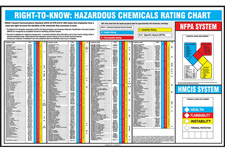



Find all of your laboratory and workplace safety supplies at Safety Emporium!
 Hazard Classification |
 Glossary Index |
 Hazwoper |
| MSDS Topics |
Free Sites | FAQ's | Regulations | Glossary | Software | Suppliers |
| Books | Forum | Poll | Fun stuff | Quiz | Store | |
| Understand your MSDS with the MS-Demystifier | Search ALL our MSDS info | |||||
As defined by the 2012 version of OSHA Standard 29 CR 1910.1200 (the OSHA Haz-com standard, HCS 2012), a hazardous chemical is one which is a physical hazard or a health hazard.

Keep informed about workplace hazards with proper labeling techniques and safety posters available from Safety Emporium.
HCS 2012 defines a health hazard as:
"...a chemical which is classified as posing one of the following hazardous effects: acute toxicity (any route of exposure); skin corrosion or irritation; serious eye damage or eye irritation; respiratory or skin sensitization; germ cell mutagenicity; carcinogenicity; reproductive toxicity; specific target organ toxicity (single or repeated exposure); or aspiration hazard. The criteria for determining whether a chemical is classified as a health hazard are detailed in Appendix A to §1910.1200 -- Health Hazard Criteria.
HCS 2012 defines a physical hazard as:
"...a chemical that is classified as posing one of the following hazardous effects: explosive; flammable (gases, aerosols, liquids, or solids); oxidizer (liquid, solid or gas); self-reactive; pyrophoric (liquid or solid); self-heating; organic peroxide; corrosive to metal; gas under pressure; or in contact with water emits flammable gas. See Appendix B to §1910.1200 -- Physical Hazard Criteria.
This resource focuses on Safety Data Sheets, but there are plenty of non-chemical hazards that OSHA also addresses. One of the most important, and one that overlaps with HCS 2012, is 29 CFR 1910.147, The Control of Hazardous Energy (Lockout/Tagout) Standard. The LOTO standard addresses seven types of hazardous energy and specifies the safety measures that employers must take to comply:
The LOTO standard only considers danger present when energy may be released in quantities or at rates that could injure employees. In contrast, the HazCom Standard considers hazardous to be an intrinsic property of a material - e.g. if a material is hazardous, it is hazardous in any amount, no matter how small. See Hazard vs Risk, below.
Under paragraph (d)(1) of HCS 2012, "chemical manufacturers and importers shall evaluate chemicals produced in their workplaces or imported by them to classify the chemicals in accordance with this section. For each chemical, the chemical manufacturer or importer shall determine the hazard classes, and where appropriate, the category of each class that apply to the chemical being classified. Employers are not required to classify chemicals unless they choose not to rely on the classification performed by the chemical manufacturer or importer for the chemical to satisfy this requirement."
Paragraph (d)(3)(i) of HCS 2012 requires those evaluating chemicals to follow the procedures described in Appendix A and Appendix B of HCS 2012 to classify the hazards of the chemicals or mixtures thereof.

Communicate workplace hazards with handy labels from Safety Emporium.
A hazard is an inherent (built-in) property of a material. Risk is the extent to which that material can cause harm. You can reduce or remove risks associated with a hazardous material, but you can not remove the underlying hazard itself (unless you get rid of the hazardous material, of course). For example, gasoline is hazardous, but it does not have a significant risk provided that proper use and storage precautions have been taken. See the last three links under Further Reading below for more information and discussion on this very fine (but very important) point.
Under the now-obsolete 1994 version of the HCS, "health hazard" was defined as a "chemical for which there is statistically significant evidence based on at least one study conducted in accordance with established scientific principles that acute or chronic health effects may occur in exposed employees. The term "health hazard" includes chemicals which are carcinogens, toxic or highly toxic agents, reproductive toxins, irritants, corrosives, sensitizers, hepatotoxins, nephrotoxins, neurotoxins, agents which act on the hematopoietic system, and agents which damage the lungs, skin, eyes, or mucous membranes. Appendix A provides further definitions and explanations of the scope of health hazards covered by this section, and Appendix B describes the criteria to be used to determine whether or not a chemical is to be considered hazardous for purposes of this standard."
HCS 1994's definition of physical hazard also differed. It defined a physical hazard as a " chemical for which there is scientifically valid evidence that it is a combustible liquid, a compressed gas, explosive, flammable, an organic peroxide, an oxidizer, pyrophoric, unstable (reactive) or water-reactive."
Hazard determination under HCS 1994 (as opposed to the considerably more rigorous hazard classification under HCS 2012) relied on these two sources to establish a chemical as being hazardous (see paragraph (d)(3) of HCS 1994):

Chemicals are not your only workplace hazard. OSHA requires the use of lockout/tagout devices for the control of hazardous energy under its LOTO standard.
Safety Data Sheets provide the necessary information for you to understand and deal with the potential hazards associated with a particular substance. Read the sheet carefully before you use a hazardous material for the first time or any time you are unsure about the hazards or necessary precautions. The SDS can help you assess and reduce the risks (but not the underlying hazards; see above) associated with the materials in your workplace.
Remember: SDS's are only required for materials that are hazardous. Often times, manufacturers are asked for SDS's for products that do not meet this requirement - manufacturers are under no obligation to produce SDS's for non-hazardous materials. Both we and OSHA discourage the production of SDS's for non-hazardous materials (listen up, corporate attorneys).
Our SDS FAQ contains more information and a list of materials that may not require SDS's under the OSHA HazCom Standard.
See also: toxic, carcinogen.
Additional definitions from Google and OneLook.
Entry last updated: Saturday, December 31, 2022. This page is copyright 2000-2025 by ILPI. Unauthorized duplication or posting on other web sites is expressly prohibited. Send suggestions, comments, and new entry desires (include the URL if applicable) to us by email.
Disclaimer: The information contained herein is believed to be true and accurate, however ILPI makes no guarantees concerning the veracity of any statement. Use of any information on this page is at the reader's own risk. ILPI strongly encourages the reader to consult the appropriate local, state and federal agencies concerning the matters discussed herein.